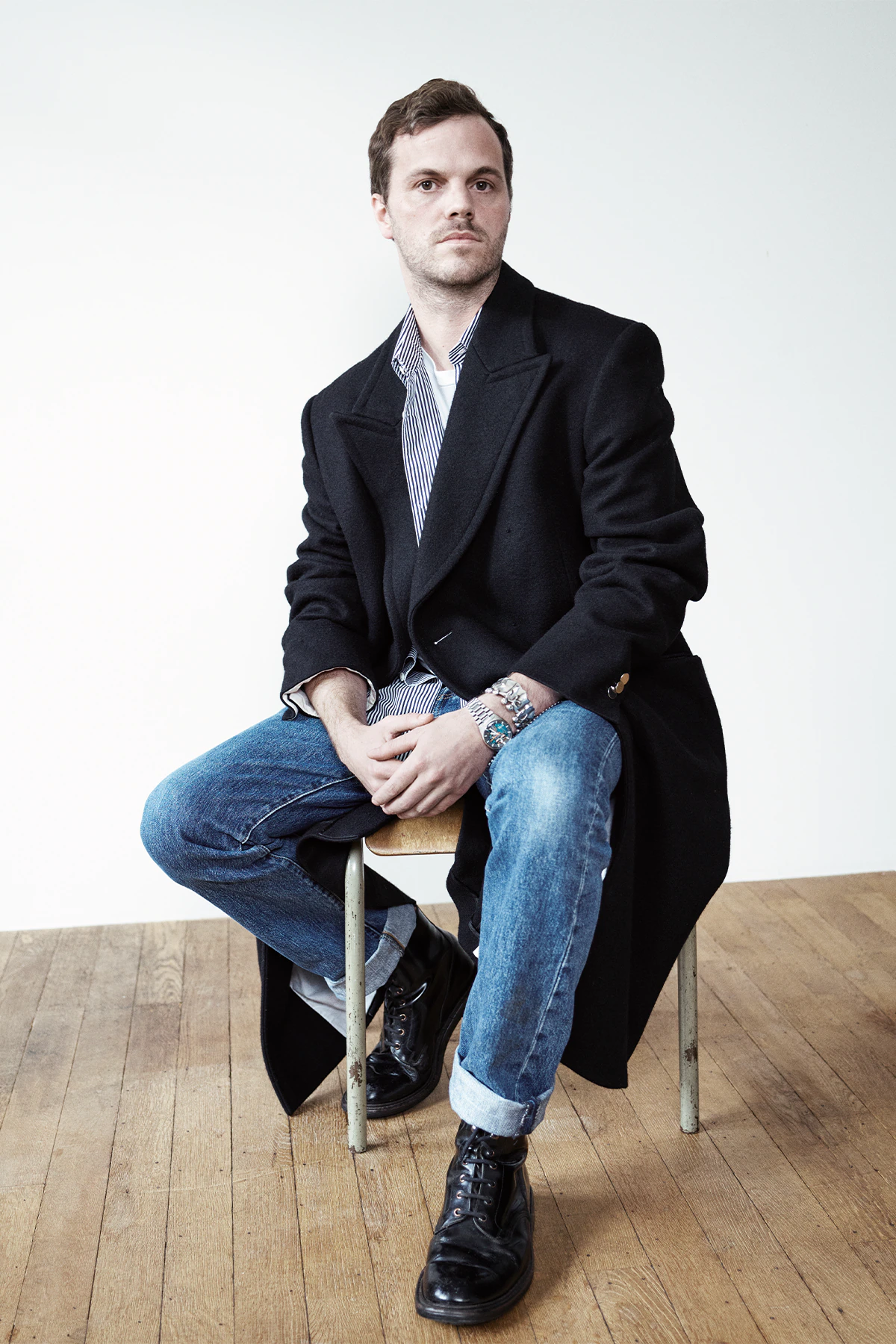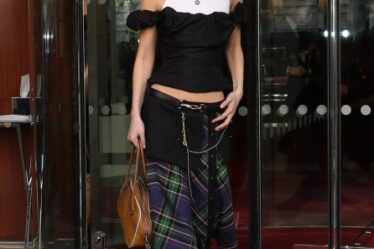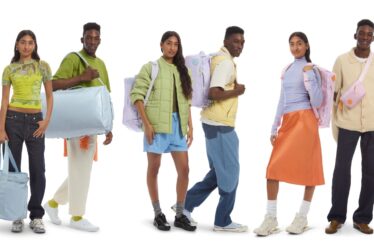
MILAN — Matthieu Blazy shows up in a Stone Island sweatshirt, bomber, jeans and cap, looking more like a teen ragazzo than the man who is about to debut his first collection as creative director of Bottega Veneta, one of the brightest jewels in the Kering crown. His predecessor Daniel Lee exited abruptly in November 2021. You can count the days Blazy, previously Lee’s design director, has had to make something new. “I’ll be honest, I’m pretty nervous,” he concedes. “I hide it behind a big smile.”
But if anyone’s ready for such a challenge, it’s him. “I really think now it’s the right time. I have enough experience and I know myself a little bit better to be able to make an objective decision and not be scared by the consequences. It’s a tough industry, but I know how to work with an atelier, I know how to work with a merchandising team. I know how the clothes are going to be translated into stock. I know how to work with a design team now. And I feel very comfortable with that. Now there is another scale, of course, like working with marketing imagery. But that’s just adding something to what I knew already. So it’s nice to be in charge.”
He says he’s been offered many creative directorships in the past but Bottega was the first one for which he felt really prepared. “This is really an environment where I can explore and work in an efficient way. Because of the link to craft, you have an incredible atelier. And it’s interesting that Bottega is a company you can reinvent each time.”
The last two re-inventions yielded major dividends for Kering. For close to two decades, Tomas Maier glossed the booming accessories business with alluringly cinematic film noir narratives. Daniel Lee went in the opposite direction, provoking rather than seducing, but still managing to galvanise a whole new audience for Bottega. “Obviously I built a relationship with a lot of people in the company in different positions. As a creative director, I can still have those kinds of relations.”
Blazy’s career stands on some remarkable shoulders. Following his graduation from Belgium’s La Cambre in 2007, he worked as a menswear designer for Raf Simons. After four years at Margiela, he was headhunted by Phoebe Philo for her Céline, where he first met Daniel Lee. Then he rejoined Simons at Calvin Klein, working alongside Pieter Mulier, Blazy’s partner, until Simons exited in 2019. Lee picked Blazy as his design director for ready-to-wear in 2020.
The comings and goings on that resumé — not just his own but some of the people he worked with, most controversially Lee’s departure from Bottega — underscore the volatility that occasionally rears its head in fashion. Blazy’s position is straightforward: no more drama. “I was given this position. I just put myself to work, without questioning the event too much.”
“We talk a lot about the dramatic situation,” he continues. “But you have everything that happened before and that was also an epiphany. I mean, we work in a tricky industry, but instead of just talking about the drama, I think it’s also important to talk about all the good things that were produced in that industry. I’ve learned a lot from every situation I’ve been in. Raf was an education. Margiela was an exploration. Calvin was an adventure. I will always remember the head of atelier at Celine from whom I learned so much about just making great clothes. And the way Phoebe put things together with such incredible style and instinct. I really took a lot of good things from them all.” And Blazy has distilled it into his own code: “Follow your gut, stick to something quite primitive as an idea, don’t overwork it, edit down. And if your idea becomes something that is not yours anymore, cancel it.”
Though he calls himself Belgian, Blazy was raised in Paris, his father French, his mother born in Antwerp. They both worked in the art world. Blazy says he spent his entire life at the auction house Drouot. ‘When you arrive, you just have this huge mass of objects from all around the world, and somehow they always create something quite coherent. One day you can buy a bed, the next day, it’s gonna be a Kees van Dongen painting. But the juxtaposition works. And my approach at Margiela was to take a lot of things that I liked and to kind of collage them. like the Exquisite Corpse game the Surrealists played. And then the solution was very simple. Does it work? Does it make sense to me? Sometimes it created a kind of monster, but in the best way. It’s interesting because it opened new doors: take something from the 20s and connect it with something produced by Nike to make something new.”
Blazy’s approach blossomed in a string of stunning collections for Margiela’s “Artisanal” label, not so much haute couture as haute collage. The source material was encyclopaedic: prom dresses from the 50s, costumes from the Beijing Opera, Art Nouveau curtains, Frank Lloyd Wright textiles, Bauhaus tapestries and on and on across time and space. The models wore eerie masks that were like art pieces in themselves. They understandably generated an enormous amount of attention. Kanye West, pop cultural weathervane, sported the densely beaded facehuggers from Autumn 2013 on tour.
It was typical of Maison Margiela that the collections were attributed to the design collective rather than any single individual in the team, though in this case the attribution was slightly perverse given the radical idiosyncrasy of Blazy’s work. But he found the anonymity convenient, relieving him of the stress of being put in front of everyone, at the same time as it allowed him to push his designs.
“I like the idea of luxury in motion, and I think the clothes should follow that.”
At Margiela, his office was in the atelier. He describes his work there as “a constant conversation, between me giving directions, inspiration, correcting things, and then working directly with the people that were making and producing those clothes.” Bottega has been somewhat the same. “You can speak directly with the people that make the clothes, with the people that make the bags. You don’t talk just to designers, you talk to the makers. And this I find incredible.” It suddenly strikes Blazy that Bottega Veneta is something of a collective itself. “It’s a factory, an Italian workshop, which is quite close to Margiela if you think about it, the idea of that maison workshop.”
“What really interests me at Bottega is that, first, it’s a bag company. So, it’s purely pragmatic. And if you have a bag company, it means that you have motion. You’re going somewhere with a bag,” he says. “I like the idea of luxury in motion, and I think the clothes should follow that. Today, when you look at all the clothes that are made, everything is made as an image, nothing is made to really move again. Or else it’s sportswear. So that’s the kind of field I want to explore.”
Of course, there will be bags. “A lot of leather, but nothing moulded, nothing made by machine. Everything is really 100 percent handmade, and we did a lot of bags that have absolutely no stitching. They’ve created an object solely by weaving. I don’t think you have to always reinvent something if it works so well. So we’ve proposed new shapes, but the technique is the same.”
If there’s one word that Blazy seems partial to, it’s “pragmatic.” He claims that’s what defines him as Belgian. It’s also the word he uses to describe his own approach to Bottega. He rattles off a self-inquisition: How do you feel when you wear the clothes? What is luxury? Is grey flannel relevant? Does it need to scream luxury? Is it modern because it’s made by a machine? Can you still create the idea of motion and energy without falling into sportswear? What would Gianni Agnelli wear? These are the questions you can expect Blazy will be trying to answer with his first show. I have my own query: Why Agnelli? “Because it’s an Italian brand and you’re talking about someone who didn’t look ‘fashion,’ just looked stylish. You know, the idea of an allure.”
“I want to reconnect with an Italian pedigree,” Blazy adds. “When Bottega was created in the ‘70s there was an incredible scene in Italy, with architects, filmmakers, furniture designers. And look at the great stuff happening in Venice, whether it’s dance, art, the cinema. I really want to root it back there.”
“So this first show for me is a base on which I’m going to build. I really want to go back to the idea of quiet power, the wardrobe. Style over screaming image. I wonder if people are going to expect me to show masks and a monster silhouette. You know, I’m also interested in just making a great pair of trousers. Can you move in them? Do they feel comfortable? Do they look good? Do you have a sense of allure and style in them? Seduction is an important word in the collection. I’m really obsessed by everything Carlo Mollino did, from his furniture to his photography. His women show a lot of flesh but they are very empowered. They don’t look like sexualised ‘90s trash. They own their sexuality, their sensuality. This I found really interesting to explore for Bottega. The idea of flesh, and maybe a more mature sexuality.”
Blazy has spoken in the past about how much he values the uniqueness and emotion of vintage clothing. He and Mulier have a huge archive in Antwerp, not just of vintage fashion, but of vernacular clothing, too, like work clothes, lingerie, even a collection of clown costumes. Mulier is now in his second year as creative director of Alaïa in Paris, which, with Blazy at Bottega in Milan, makes for fashion’s most fascinating power couple. And perhaps its most tortured, not only in terms of the time they no longer get to spend together, but also with all the topics that must remain off the table in their conversations. In a funny way, the archive has been a big help. “During the first lockdown, we really reorganised it, and it was a good opening to discuss fashion with Peter without talking about our jobs. We never talk about work. We never show each other anything. Never. But we always talk about fashion and art and design.”
And if vintage was able to offer some emotional succour during their lockdowns, it has obviously served Blazy incredibly well in his own career. “But I felt like I had to turn that page a little bit,” he says now. He didn’t work with vintage at all for his Bottega debut, though there was one image he cherished while he was designing because he says it so beautifully conveyed the emotion that attaches itself to clothes. It’s a random photograph from the ‘40s of a boy wearing a handknit sweater. “Probably made by his grandmother, and it’s not well-made, which is also quite beautiful. But the pride he has wearing it! I like the idea that he’s going to keep this sweater forever because it’s very precious. And it looks precious, although it isn’t at all. So, we also looked for that when we were making the clothes. Do they look like they have emotion? The question was always: could they be unique? Not that we try to do something vintage, that’s not the idea at all. It’s more when you look at this, can it become precious to you? Does it look handmade? Is it perfect? Not really. But would I wear it? Yes, immediately.”
“This I found really interesting to explore for Bottega. The idea of flesh, and maybe a more mature sexuality.”
“This obsession with technology and newness, I find it’s something that I question. Because it may be new in the manufacturing but is the result really new? You can’t say about craft and hand-making that it’s out of date. It’s not because you make something by hand that it’s not new. It’s really the question of longevity. Craft for me is timeless. What I question is the obsession with that, in always trying to make something that looks visually new, you have to use a new technology. I think it’s wrong.”
And yet Daniel Lee did seem to light on “newness” at Bottega by confounding people’s expectations. If everybody’s talking about the search for beauty in fashion, give them things that border on ugly and they look new, or, at the very least, unexpected. This idea excites Blazy. He asks if I know the Italian intellectual Umberto Eco’s influential text “History of Ugliness,’ with its proposal that ugliness is more fun than beauty. “We could talk all day about that. Look at what Miuccia says about the quest for beauty through ugliness. I think it resonates in all of history. But the question for me is not so much, ‘Is it ugly or beautiful?’ but ‘Am I attracted to it, and why?’ Some people might find it very ugly and I’m fine with that.” For example, you’ll see lace in the new collection. Blazy doesn’t like lace but he was so attracted to the incredible lace-clad women in Carlo Mollino’s work that he felt he needed to explore his aversion a bit more, to understand, maybe even dismiss it.
There is clearly a particularly bright spotlight on Blazy, given the circumstances of his ascent at Bottega and expectations that he will keep up the brand’s momentum. “Obviously the proposal is very different, but for me the continuity comes with the craft.”
One touchstone for the new collection is a 1913 sculpture by the Italian Futurist Umberto Boccioni. He first came across it in one of his parents’ art books. Its full title is “Unique Forms of Continuity in Space” and it captures a muscular man in mid-movement. It looks a little like a Francis Bacon rendered in bronze rather than paint. “There is something extremely alluring about it. It goes somewhere. There are a few silhouettes that I really want to express that idea of motion.”
“When you look at this, can it become precious to you? Does it look handmade? The obsession with technology and newness is something that I question.”
The Boccioni inspired Blazy to address the two-dimensionality of fashion. “It’s funny to think that most of what the audience sees on Vogue Runway is two-dimensional. We never talk about the profile anymore, or the back. So we’ve challenged ourselves on this idea. Maybe it’s very boring from the front, reading in 2D, like a certain idea of classicism, and then when you experiment with the silhouette in profile, you have this idea of the allure, the movement. I also like the idea to work on the back, to really go back to the idea of 3D-ness around the silhouette.”
How the clothes will be perceived on the catwalk brings us to the issue of presentation. Over the past two years, Lee introduced his collections with a series of unpredictable, often tech-y interventions. And when it was finally possible to stage a proper old-school show, he chose Detroit as his venue. Under Blazy, Bottega, like Kering anchor Gucci, is back on the fashion calendar in Milan. It’s a homecoming both literal and figurative. “I don’t think that being radical is always the right solution for radicalism,” he explains. “It’s also interesting to work within the framework of the industry. Sometimes you’re more creative. You can do whatever you want. I’m very comfortable with the idea of showing back in Milan. We’re doing the show in the new headquarters which are completely destroyed at the moment. I thought it was nice to already connect what we are doing now to that new building. I’m not saying that every show will be Milan but for now, I think it was nice to reconnect and also be part of a bigger conversation.”
The show invitation is a piece of green leather, left over from the bags. “I think it was interesting to touch the quality, something very physical,” says Blazy. It’s been two years since Lee imposed that very specific green in an effort to create a visual identity for Bottega, like Hermès with its orange or Tiffany with its robin’s-egg blue. It was a typically provocative gesture. Green is traditionally a very hard sell at retail. And, according to Blazy, green perfumes don’t sell either. (He has always worn one: Vetiver by Guerlain). So why hold on to this ambiguous fragment of the immediate past?
Blazy accepts the inevitability of a teething period while he takes over. That’s why he’s still drawn to the green. It’s the same shade as the greenscreen in cinema, where anything can be made to happen. “You have this transition from Daniel to me, so why not push the green as a screen?” It’s already happening on the app Bottega just launched. “We can project any imagery to maintain a conversation with people who are interested in seeing what we’re doing.”
“We’ll see, you know,” Blazy adds. “Today I’m telling you flannel, tomorrow I may be telling you baroque and in five seasons, maybe it’s going to be about the matrix.” Fine with me, as long as it’s not green.



